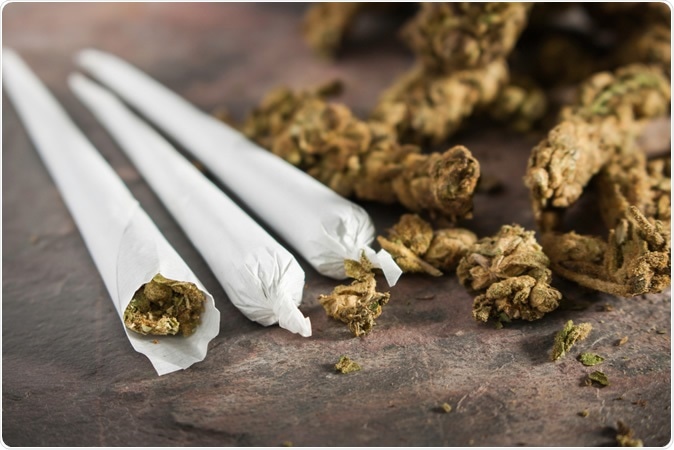
Image Credit: Craig F Scott / Shutterstock
The team of researchers found that over the past year daily use of marijuana was higher among gay, lesbian and bisexual women compared to heterosexual women. The researchers looked at three parameters – “state-level medical marijuana laws (MMLs) and marijuana use (MU) and MU disorder (MUD)” among the American population and said that this was the first study that looked at MML, MU and MUDs among LGB individuals (lesbian, gay and bisexual).
Morgan Philbin, assistant professor of Sociomedical Sciences at Columbia's Mailman School said, “Our work builds on the Institute of Medicine report highlighting the importance of conducting additional research on LGB populations across the life course. While research has explored how LGB discrimination polices may impact substance use, less work has explored how substance use policies may impact LGB men and women differently than heterosexuals.”
The team of researchers looked at marijuana use among a adult population of around 126,463 individuals from the National Survey on Drug Use and Health. They looked at the marijuana consumption over the past year among these individuals. In addition they also assessed daily or nearly daily use of marijuana and MUDs among these individuals. Finally they looked at the connection between states of residence, medical marijuana laws prevalent in that state and declared sexual identity of the individuals. A correlation between these factors was assessed by the team.
Once the data obtained was analyzed the team found that women who had LGB identity living in MML states had a higher daily or near daily MU compared to LGB women from non-MML states. The high levels were found to be 300 or more days in a year. Bisexual women living in MML states had a higher MU compared to bisexual women living in non-MML states. Both LGB women from MML states thus had a higher medical MU compared to those living in non-MML states.
The authors wrote, “Sexual minorities, including individuals who identify as lesbian, gay, or bisexual (LGB), also report higher levels of MU and MUD than their heterosexual counterparts. The 2015 National Survey on Drug Use and Health (NSDUH) found that 30.7% of sexual minority adults reported past-year MU compared with 12.9% of heterosexuals; 3.9% reported MUD compared to 1.3% of heterosexuals.”
The team also compared MU among LGB women and heterosexual women. Silvia Martins, MD, PhD, associate professor of Epidemiology and senior author of the study said in a statement, “We further extended these findings to estimate daily/near-daily MU prevalence, which was seven times higher among bisexual women than heterosexual women and 2.3 times as high for bisexual men compared to heterosexual men.”
They found that marijuana use was around 10 percent among straight women in the past year. This prevalence was 26 percent among gay or lesbian women and 40 percent among bisexual women, the researchers found. Daily use also was only 1.5 percent among heterosexual women compared to 6 percent among lesbian women and 10 percent among bisexual women. The prevalence of MUDs also showed a similar picture the authors of the study wrote. Medical MU also revealed a similar picture with around 1 percent among straight women, 5 percent among lesbian or gay women and 5.5 percent among bisexual women.
The team reported a comparative picture with men as well. They found that past year MU was 17 percent among straight men, 30 percent among bisexual men and 29 percent among gay men. Similarly daily MU was 4 percent, 7 percent and 9 percent among heterosexual men, gay men and bisexual men respectively. Past year medical MU was 2 percent, 5 percent and 4 percent among heterosexual men, gay men and bisexual men respectively. The rates of MU was not different for men living in MML states and non-MML states, the study noted.
Philbin explained, “Our results support existing literature by demonstrating that bisexual women have higher marijuana use disorder compared to heterosexual women. This is part of a larger health burden, as bisexual women are twice as likely to have co-occurring mental health and substance use disorders yet often have little contact with service providers.”
The authors wrote in conclusion, “This research demonstrates the need to allocate resources that target sexual minority women, particularly bisexual women. This work also suggests the need to design future surveys in ways that better capture how individuals identify and to whom they are attracted, in addition to capturing behavior. Doing so will allow us to do a better job of addressing specific, unmet needs, particularly for smaller populations (e.g., those identifying as ‘don’t know/refuse to answer’).”
Martins echoed the sentiment in a statement saying how important this issue was from a public health perspective. She said, “This study represents an important contribution to the literature on the structural determinants of substance use for LGB individuals and demonstrates the need to allocate resources that target sexual minority women, especially as medical marijuana laws and recreational marijuana laws continue to change at the state level.” She added, “Future surveys that capture how individuals identify will help us pinpoint how state-level marijuana policies may differentially impact specific sub-populations, ultimately advancing the development of more health-promoting policies for all.” Authors of the study wrote in conclusion, “This research can also help identify how state-level marijuana policies may differentially impact specific sub-populations, ultimately promoting the development of more health-promoting policies for all.”
Journal reference:
Morgan M Philbin, Pia M Mauro, Emily R Greene, Silvia S Martins, State-level marijuana policies and marijuana use and marijuana use disorder among a nationally representative sample of adults in the United States, 2015-2017: Sexual identity and gender matter, Drug and Alcohol Dependence, Volume 204, 2019, https://doi.org/10.1016/j.drugalcdep.2019.06.009., http://www.sciencedirect.com/science/article/pii/S0376871619302650